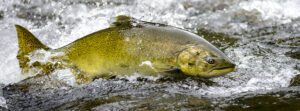
An above average run of salmon was forecast for the 2023 Copper River commercial salmon opener, which began on May 15, with processors planning to move much of the first catch via Alaska Airlines to the annual ceremonial welcome mat at SeaTac Airport in Seattle.
OBI Seafoods and Copper River Seafoods, along with Trident Seafoods, which is marking 50 years in the industry in 2023, were slated to have Chinook and sockeye salmon on the flight to Seattle, arriving on May 16.
Trident Seafoods chief executive officer Joe Bundrant said his company is grateful to all the independent fishermen who continue to partner with Trident and deliver the fresh, high quality fish.
“Our history of partnership with Copper River goes back many years and we look forward to continuing working together in responsibly sharing the best from Alaska with the world,” he said.
“As this momentous season launches here in Cordova, we are so pleased that we could revisit and share the history of how the revered Copper River king salmon made a leap into a new realm, added Christa Hoover, executive director of the Copper River Prince William Sound Marketing Association.
“It has been incredibly satisfying to see how the fishery has evolved and yet remained steadfastly committed to quality for the consumer,” she said.
At Alaska Airlines, Adam Drouhard noted that Alaska Air Cargo has had a special partnership with the Alaska seafood industry, which is recognized worldwide for its sustainable fishing practices.
“Our cargo employees across more than 110 airports are working around the clock to ensure we deliver the first catch of wild Copper River salmon to market, often within 24 hours of being pulled from the water,” Drouhard, the cargo facility’s managing director, said.
Meanwhile, Alaska Department of Fish & Game biologists on May 15 announced an anticipated pink salmon harvest of 19 million humpies, with a range of 12 million to 29 million fish.
Chinook salmon stocks in Southeast Alaska continue a trend of low abundance, with 11 monitored Chinook salmon index systems not meeting escapement goals. That includes 2.8 million fish in five Douglas Island and pink and chum locations, 3.3 million fish to six Northern Southeast Regional Aquaculture Association locations and 3.1 million fish to six Southern Southeast Regional Aquaculture Association locations.
